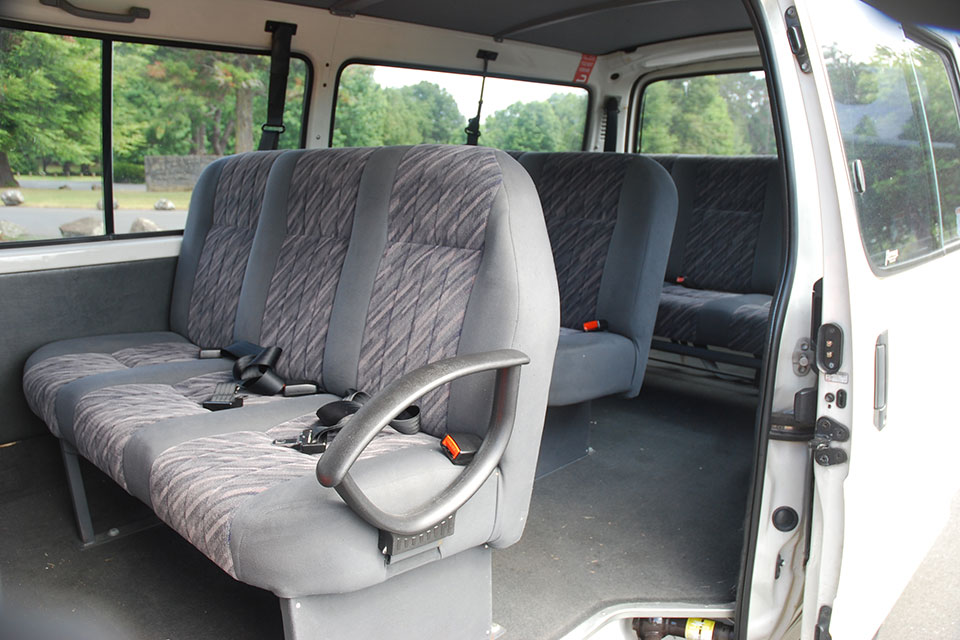Toyota Hiace 1989-2004 used minibus review
The Toyota Hiace minibus is a reliable and affordable way to transport family, friends or workers.

The Toyota Hiace minibus is a reliable and affordable way to transport family, friends or workers. Safety levels are deficient.
The Toyota Hiace van has long been the most popular van for New Zealand buyers and, although most are cargo vehicles, some are fitted out to carry passengers. The minibus version is available in three lengths with two roof heights: short, long, and extra-long; high roof.
This model is a relatively basic vehicle – if you want luxury, the “Super Custom” model trades off seat numbers for comfort features. Some import models are based off the Regius though they are essentially the same.
Inside and out
The Hiace is a “cab-over” style van – that means the driver and front-seat passengers sit over the front wheels and engine and there is no bonnet. Overall, it’s a large box with rounded edges for a softer look. There are two slightly different front-end designs: a flat front like the one on our review vehicle and most Japanese imports, and a more angled design found on all New Zealand-new models. Steel wheels without trims are standard.
The interior is durable and basic. You climb up into the driver's seat using a step in the doorway and a grab handle. The dash is a large, rounded rectangular pod. There are slider controls for the manual air-conditioning – it was fitted to almost all imports and is an option on New Zealand-new models. Our van features an aftermarket CD player stereo but most imports have only a basic radio which will require a band expander to receive local stations.
Most surfaces, including the door trims, are hard, sturdy plastic. There are no electric windows and the old-fashioned wind-up type is common. The centre seat can be folded forward which provides a storage area and cup holders. This van is an 11-seater, though nine and 15-seat options are available depending on van size.
Three sit across the front, with a row of three, then a row of two and another row of three in the rear. The advantage of the Hiace layout is that all three rows can access the side door, a requirement for some passenger service licensing. All the seats are reasonably spacious, though knee space in the second and third row can be a little tight. None of the rear seats feature headrests.
The ceiling and part of the interior sides are bare, exposed metal. It’s worrying that there is no separate air-conditioning blower in the rear and only the second-row windows slide for ventilation.
With the fourth row in place, there is little luggage space, just enough for three medium cases standing upright. This seat can be folded down to increase the space considerably. A luggage trailer is commonly used with this type of vehicle to allow all available seats to be used.
On the road
This generation Hiace is available with 2-litre and 2.4-litre petrol and 2.4-litre, 2.8-litre and 3-litre diesel versions. Our review vehicle is powered by the 3-litre four-cylinder turbocharged diesel engine, paired with an optional four-speed automatic. A five-speed manual is standard. The engine produces 96kW and 289Nm, which was reasonable for a diesel engine when it was introduced.
In such a large vehicle it feels adequate, despite being rather loud, and the transmission likes to hold in gear for a long time when you accelerate. The Hiace feels tall and heavy, with a lot of body roll and little feel to the steering.
The brakes are reasonable although they are likely to come under pressure with a full load of passengers on board – you are best just to take it easy in a vehicle like this. Where it does shine is in town – excellent visibility from the driver's seat, a tight turning circle and the flat front makes it easy to get through relatively tight spaces.
Special mirrors allow you to see how close you are front and rear, though they take some getting used to. Parking sensors and reversing cameras were not standard on any Hiace of this generation. They are an excellent addition, which you can do yourself from $50 or have a professional do it from $200.
We could not find a specific tow rating for the Japanese model Hiace. New Zealand-new models can pull 700kg unbraked (a medium-size garden trailer) and 1,500kg braked (a small trailer boat).
Safety
RightCar lists the Hiace minibus as having a low one-star Used Car Safety Rating, based on real-world crash results. Safety specifications are almost non-existent. There are no airbags or anti-lock braking as standard on import models, though a driver's airbag was fitted to the New Zealand-new version from 1998.
There are no ISOFIX child seat mounts in the rear. Only the window seat positions get full shoulder-style seat belts; the rest get lap-only belts which offer minimal protection.
Reliability
This generation Hiace is regarded as very solid and well built – so much so that there is a market that sells Hiaces considered too low in quality for the New Zealand market to the Pacific islands and Africa.
Cargo vans are likely to have lived a hard life while passenger versions of this model will have been treated far better. Still, it is crucial to pay particular attention to the bodywork of any Hiace you plan to buy.
Look for signs of repairs, paint cover-ups and bubbling through. The serious nature of corrosion in this model stems from the location – they tend to rust around key structural areas that in turn lead to Warrant of Fitness failures.
Key areas to watch for are around the rear side window frames, especially the lower section of the frame and the panel immediately below. Water and condensation collects over time inside the bodywork, the rear door around the window, along the roof drip rails, the A-pillars beside the windscreen and the inside of the doors.
Manual transmissions can suffer from final drive whine and noise, and fourth and fifth gears can wear, highlighted by a grating noise. Look at the driver’s seat for signs of wear to the seat squab – these usually collapse after years of use.
Cost of ownership
A Hiace requires servicing every year at a cost of around $280. The cam belt requires replacement every 90,000km – expect a bill from $1,000 for that.
RightCar estimates a 3-litre diesel Hiace will cost $3,140 per year in fuel and road user charges. The 70-litre diesel tank will cost $105 to fill at $1.45 a litre and should take you 802km until the fuel light comes on.
Diesel-powered Hiaces pay Road User Charges and an annual licensing fee (registration) of $227.03.
Trade Me Insurance estimates cover for a minibus valued at $8,800 can cost from $46.94* per month. This price is for private use and business users will need additional protection.
Buyers' guide
Hiace minibusses of this generation are available on Trade Me from $5,000 to $14,000. Mileage is a significant factor in influencing value and the “jumbo” extra-long wheelbase versions also fetch more.
Variants
There is one basic version of the minibus from Japan and New Zealand, with air-conditioning on the import version the most common specification difference. The New Zealand-new model is technically a ZL specification and the extra-long wheelbase model is called the Commuter.
Some minibus models are also likely to be commercial models with aftermarket seats fitted. That means you should shop for the Hiace to meet your needs, not just a specific model.
Timeline
- 1989 Launched internationally
- 1994 Given cosmetic facelift
- 1997 Given cosmetic facelift
- 1998 Airbag added to New Zealand models
- 2002 Given cosmetic facelift
- 2004 Replaced by new model
Details
2002 Toyota Hiace minibus
$8,000 to $14,000 for models which have travelled 70,000 to 120,000km
3-litre, four-cylinder turbocharged, 96kW and 289NM
Four-speed automatic, rear-wheel drive
One-star Used Car Safety Rating
12 months
Full size spare
8.1-litres per 100km (claimed)
Diesel
4430mm
1695mm
2920mm
700kg (unbraked), 1500kg (braked)
10.6m
This review covers the Toyota Hiace for model years 1989, 1990, 1991, 1992, 1993, 1994, 1995, 1996, 1997, 1998, 1999, 2000, 2001, 2002, 2003, and 2004.
Review vehicle supplied by Turners Cars.
*Our insurance estimates are based on a 35-year-old male with no accidents in the last two years, garaging the car in Mission Bay, Auckland. The car is not used for business and will cover 10,000km to 20,000km a year. We estimate with no option add-ons and $500 excess. Customise your estimate at Trade Me Insurance.
Image gallery
Also consider






